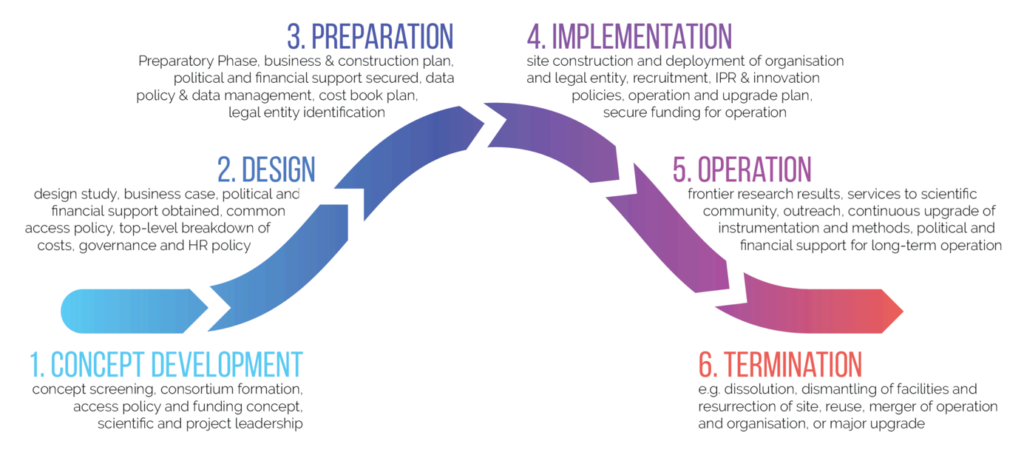What is ESFRI
SLICES-RI (SLICES-RI website) entered the ESFRI Roadmap in 2021, as an ESFRI Project. But what is ESFRI? The following text will present you the key elements to be known about ESFRI, taken from different ESFRI sources (ESFRI Strategy report on Research Infrastructures – Roadmap 2021; ESFRI Roadmap 2021 Public Guide; ESFRI White Paper 2020 – Making Science Happen; ESFRI website)
ESFRI, the European Strategy Forum on Research Infrastructures, established in 2002, brings together national governments, the scientific community, and the European Commission, to support a coherent and strategy-led approach to policy making on Research Infrastructures in Europe.
Equipping Europe with infrastructures for ground breaking research is at the heart of the ESFRI Roadmap. The Roadmap contains probably the best European science facilities based on a thorough evaluation and selection procedure. The ESFRI Roadmap combines ESFRI Projects, which are new Research Infrastructures in progress towards implementation, and ESFRI Landmarks, successfully implemented Research Infrastructures. The Strategy Report on Research Infrastructures 2021 (https://roadmap2021.esfri.eu/media/1295/esfri-roadmap-2021.pdf ) includes the Roadmap 2021 and the ESFRI vision of the evolution of Research Infrastructures in Europe, addressing the mandates of the European Council, and identifying strategy goals.
ESFRI applies a lifecycle approach to the development and implementation of Research Infrastructures (see Figure 1below). The lifecycle concept describes the different milestones in the development, implementation and operation of a Research Infrastructure over time, specifying minimal key requirements that must be met at each stage. Application of this concept allows for a coherent assessment of the scientific and organisational maturity of Research Infrastructures across all fields of science.

The concept of a new Research Infrastructure (RI) typically emerges bottom-up from the scientific communities clustering around well identified scientific needs and goals. Such a concept can originate from completely novel approaches to answer scientific questions or to respond to the need of enhanced capacity at pan-European level as well as from new insights in existing RI – e.g. resulting in a plan for major upgrade or merger.
To be eligible for evaluation, new proposals must meet the three eligibility criteria: (i) political support by the lead MS/AC (EU Member States / Associated Countries ) and at least two additional MS/AC, (ii) funding commitment by the Lead MS/AC, and (iii) inter-institutional and multi-lateral agreement signed by the core partners.
ESFRI has developed and applies distinct and transparent evaluation, monitoring and periodic review mechanisms based on two independent processes, i.e. i) the evaluation of the Scientific Case through the Strategy Workings Groups (SWG) and ii) the evaluation of the Implementation Case through the Implementation Group (IG).
The SWGs evaluate the Scientific case along five dimensions: (i) scientific excellence, (ii) pan-European relevance, (iii) socio-economic impact, (iv) user strategy and access policy, and (v) e-needs. The Implementation Group (IG) evaluates the implementation case along five dimensions: (i) stakeholder commitment, (ii) preparatory work and planning, (iii) governance, management and human resources, (iv) finances, and (v) risks. ESFRI applies minimal key requirements (MKR) on all dimensions described above and along the RI life cycle.
Projects are RI in their Preparation Phase, which have been selected for the excellence of the Scientific case and Implementation case, according to a sound expectation that the Project will reach the Implementation phase within the ten-year term. They are included in the Roadmap in order to underline their strategic importance to the ERA (European Research Area ) and to support their timely implementation.
Projects, that have entered the ESFRI Roadmap, have thus met the MKRs on all dimensions regarding the Preparation phase, which include the outline of the scientific vision and mission (based on the scientific questions), the scientific concept tested and found feasible, the definition of the positioning in the RI landscape, a political support provided by a satisfactory number of prospective members, the design study successfully completed, a survey demonstrating the user community, an overall plan for all phases of the lifecycle, a cost book with top-level breakdown of cost elements, a governance outline with the target to establish the legal entity before the implementation. It also includes the identification of funding opportunities, the outline of the in-kind contribution policy, the analysis of major risks and mitigation strategies, the definition of KPIs, and the outline of the HR policy and plans.
For RIs to remain relevant throughout the entire RI lifecycle, scientific excellence is the condition sine qua non, which becomes, together with adequate human resources, crucial when it comes to long-term persistence in the operational phase. Effective governance and sustainable long-term funding (public and private) are other key elements for ensuring long-term sustainability of RIs at every stage in their lifecycle.
Since 2002, within the framework of ESFRI and the ESFRI Roadmap process, national governments have worked in close partnership with the European Commission and the scientific community to catalyse the establishment of over 50 European Research Infrastructures, mobilising investments of approximately €20 billion across the EU.

